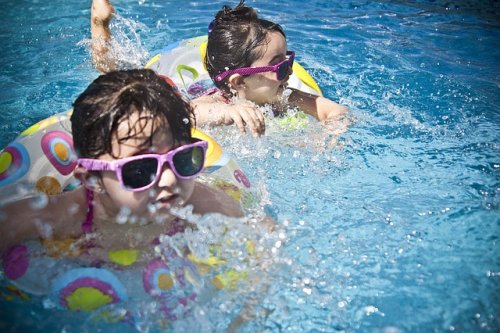Risk of Sun Stroke in Children

Along with high temperatures, water fun and vacations, summer brings along some climatic conditions that we must pay attention to. Sun stroke in children is one of them. This is defined as a prolonged exposure to sunlight that can become serious if we don’t take precautions.
Surely you’ve heard about appropriate summer care for certain age groups, including children and the elderly. We can also add people with skin problems or diseases that require specific precautions to the list.
It’s vitally important that you know and respect these guidelines to protect your children’s health.
With their desire to go out and have fun and play, children often don’t pay attention to summer’s unfavorable weather conditions, especially at certain times of day. That’s when parents must take precautions to prevent the risk of sun stroke in children.
Consequences of sun stroke in children
Sun stroke, also called heat stroke, generates a very large imbalance in a child’s body. In this way, it becomes unable to regulate temperature and to fulfill the vital functions that ensure its proper functioning.
The reason why children may suffer the harmful effects of the sun and high temperatures has to do with their lack of maturation. Both the immune system and other parts of the body, such as the skin, don’t have the necessary resistance yet to withstand the shocks of sudden changes.
In addition to a fatal outcome, sun stroke can also cause very serious problems, such as skin burns and related diseases. It has also been related to brain problems and even coma, according to some experts.
It’s important to act quickly in these cases, because if the body isn’t able to regulate its temperature, death can occur in less than an hour.

Symptoms of sun stroke in children
A sun stroke can cause the following symptoms in children:
- Pallor
- Cramps
- Fainting
- Weakness and fatigue
- Excessive sweating
- Headaches
- Fever above 102.2F
- Dizziness, nausea and vomiting
- Decreased blood pressure
Recommendations to prevent sun stroke in children
Prevention is the most effective measure that parents can adopt to protect their children from these serious problems. Some tips to prevent it from happening include:
Avoid prolonged sun exposure, especially at certain times
In the summer months, children shouldn’t be exposed to sunlight between the hours of 11 and 5. In addition, it’s important that they never be exposed to sun for more than 2 hours at any time.
Of course, the use of sun screen is mandatory. Physical activity at these times should be prohibited.
“When suffering from sun stroke, the body becomes incapable of regulating its temperature and fulfilling the vital functions that ensure it works properly.”
Hydration
Children are distracted by nature and don’t walk around all day thinking about when they last drank water.
It’s necessary for the adults in charge to offer children something to drink from time to time so they can cool down and stay hydrated. This is especially important when they play outdoors, even in the pool.
Pay attention to their behavior
If a child feels fatigued, apathetic or weak for no reason, he or she may have lost electrolytes and water. A sun stroke may be about to occur. At that time, adults should take action as soon as possible to treat this condition.

What to do in the event of sun stroke in children
If your child has sun stroke, you should immediately go to the nearest hospital. Meanwhile, you must try to lower their body temperature with compresses or cold cloths. The chest, neck and head are essential places, in addition to the thighs and arms.
On the other hand, try to keep them in a cool place. As long as the child is lucid, give them water to stay hydrated. Be careful that they don’t choke. Take off all the clothes you can, especially for babies.
With these emergency tips and immediate medical attention, the effects of sun stroke can be alleviated.
Finally, remember that this problem doesn’t only happen in summer. It can occur in any season whenever anyone stays under intense solar rays for too long.
Along with high temperatures, water fun and vacations, summer brings along some climatic conditions that we must pay attention to. Sun stroke in children is one of them. This is defined as a prolonged exposure to sunlight that can become serious if we don’t take precautions.
Surely you’ve heard about appropriate summer care for certain age groups, including children and the elderly. We can also add people with skin problems or diseases that require specific precautions to the list.
It’s vitally important that you know and respect these guidelines to protect your children’s health.
With their desire to go out and have fun and play, children often don’t pay attention to summer’s unfavorable weather conditions, especially at certain times of day. That’s when parents must take precautions to prevent the risk of sun stroke in children.
Consequences of sun stroke in children
Sun stroke, also called heat stroke, generates a very large imbalance in a child’s body. In this way, it becomes unable to regulate temperature and to fulfill the vital functions that ensure its proper functioning.
The reason why children may suffer the harmful effects of the sun and high temperatures has to do with their lack of maturation. Both the immune system and other parts of the body, such as the skin, don’t have the necessary resistance yet to withstand the shocks of sudden changes.
In addition to a fatal outcome, sun stroke can also cause very serious problems, such as skin burns and related diseases. It has also been related to brain problems and even coma, according to some experts.
It’s important to act quickly in these cases, because if the body isn’t able to regulate its temperature, death can occur in less than an hour.

Symptoms of sun stroke in children
A sun stroke can cause the following symptoms in children:
- Pallor
- Cramps
- Fainting
- Weakness and fatigue
- Excessive sweating
- Headaches
- Fever above 102.2F
- Dizziness, nausea and vomiting
- Decreased blood pressure
Recommendations to prevent sun stroke in children
Prevention is the most effective measure that parents can adopt to protect their children from these serious problems. Some tips to prevent it from happening include:
Avoid prolonged sun exposure, especially at certain times
In the summer months, children shouldn’t be exposed to sunlight between the hours of 11 and 5. In addition, it’s important that they never be exposed to sun for more than 2 hours at any time.
Of course, the use of sun screen is mandatory. Physical activity at these times should be prohibited.
“When suffering from sun stroke, the body becomes incapable of regulating its temperature and fulfilling the vital functions that ensure it works properly.”
Hydration
Children are distracted by nature and don’t walk around all day thinking about when they last drank water.
It’s necessary for the adults in charge to offer children something to drink from time to time so they can cool down and stay hydrated. This is especially important when they play outdoors, even in the pool.
Pay attention to their behavior
If a child feels fatigued, apathetic or weak for no reason, he or she may have lost electrolytes and water. A sun stroke may be about to occur. At that time, adults should take action as soon as possible to treat this condition.

What to do in the event of sun stroke in children
If your child has sun stroke, you should immediately go to the nearest hospital. Meanwhile, you must try to lower their body temperature with compresses or cold cloths. The chest, neck and head are essential places, in addition to the thighs and arms.
On the other hand, try to keep them in a cool place. As long as the child is lucid, give them water to stay hydrated. Be careful that they don’t choke. Take off all the clothes you can, especially for babies.
With these emergency tips and immediate medical attention, the effects of sun stroke can be alleviated.
Finally, remember that this problem doesn’t only happen in summer. It can occur in any season whenever anyone stays under intense solar rays for too long.
This text is provided for informational purposes only and does not replace consultation with a professional. If in doubt, consult your specialist.








